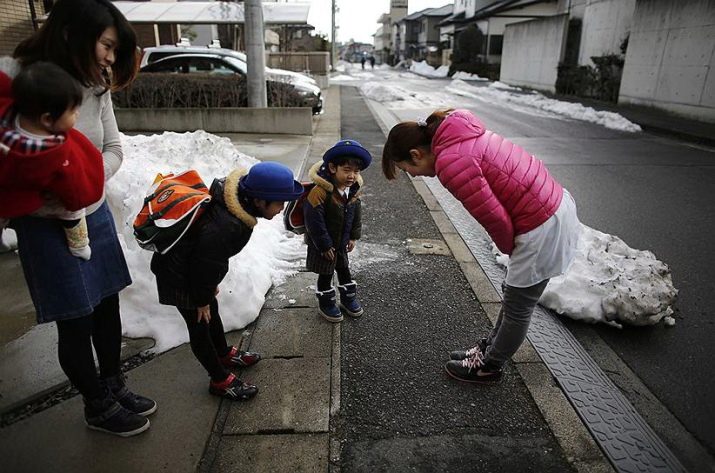Speech etiquette: the subtleties of the culture of communication

In any place, wherever there is a person, it is always customary to speak politely to the interlocutor. Every day we say hello, thank you, apologize, offer, ask for something, say goodbye. Speech etiquette - the ability to communicate politely with the interlocutor. Using etiquette in everyday communication will help you build good and trusting relationships with people.
Features
Human communication and human speech from ancient times play a huge role in the life and culture of mankind. Speech culture is reflected in the languages of various countries and peoples. Thanks to linguistic traditions, we have an idea about the culture of countries, about their national values and worldview.
Human speech is the most important feature by which one can understand the level of development and literacy of a person. Do not underestimate the importance of etiquette in the life of any person, since it is he who often acts as a connecting element in work and social life.
Speech etiquette implies a complex of norms, thanks to which a person understands how to communicate, maintain relationships with other people in different life situations. The rules of etiquette are very diverse, there is no common single "formula" of communication. Any country is rich in its cultural subtleties of communication.
This type of etiquette interacts with the very practice of communication, its components are in any conversation. If you correctly follow the rules of speech etiquette, then you can competently and clearly convey to the person what you want from him. Mutual understanding and sympathy are also achieved much faster.
Speech etiquette borders with other humanities - linguistics (as well as its subsections - morphology, lexicology, style, phonetics, phraseology, etymology and others), psychology, and, of course, cultural characteristics of other countries.
To successfully master the skills of cultural conversation, one should use speech etiquette formulas.
Starting formulas are vaccinated to the child since childhood. This is what our parents teach us - how to greet a person correctly, say goodbye, express gratitude, apologize. Getting older, each person adopts new features in communication, learns different types of speech.
It is important to note that the ability to politely maintain a conversation with an opponent, correctly express your thoughts, shows you as a polite interlocutor.
So, the etiquette formulas are the totality of universally recognized words and expressions that are used in conversation. They are applied in three stages of conversation:
- The beginning of the conversation (greeting). Phrases that are chosen for greeting depend on your interlocutor. It is important to consider his gender, age, social status. No hard frames. The standard greeting is “Hello! Or good morning! ". Such treatment is universal and suitable for everyone - both for your friends and relatives, and for the authorities.
- Main part of the conversation. Here the formulas depend on the purpose of the conversation.
- Conclusion. According to the general rules, it is customary to say goodbye or arrange a subsequent meeting. You can use the universal options: “Goodbye! "Or" All the best. "
A bit of history
As noted above, etiquette - these are some rules of behavior that are instilled in a person since childhood. The concept of the basis of this definition is based on cultural values. Compliance with these norms helps build good relationships with people. Today's rules of etiquette are not deliberately invented.Words, phrases and various techniques of conversation have been formed for centuries in the process of communication between people.
The word "etiquette" has a Greek origin. It means "order." In the future, the word stuck tightly in France. It began to be used at the end of the 17th century, during the reign of Louis XIV. The word "Etiquette" denoted a card, which indicated the norms of behavior at the table of the king.
The rules of speech etiquette formed in ancient times, when a person was just beginning to learn how to build relationships with his interlocutor. Already in those times, certain norms of behavior began to form, helping to gain understanding and make a favorable impression on the interlocutor.
The norms of correct behavior can be found in the manuscripts of the inhabitants of ancient Greece and ancient Egypt. In those days, these norms were a kind of ritual, with the help of which people could understand that they do not pose a threat to each other, think "on the same wavelength."
Functions
The basic purpose of speech etiquette - the formation of communication and contact between groups of people. Compliance with the general rules and regulations makes the interlocutor more understandable to other people. We understand what can be expected of him, as we begin to trust familiar communication skills.
This feature originated in ancient times, when a man was everywhere in danger. At that time, adherence to ritual communication was very important. When another person, who was the interlocutor, performed familiar and understandable actions, called the necessary and understandable words, this greatly simplified the interaction, softening mistrust.
Now we at the gene level understand that a person who observes these norms can be trusted. Norms form a favorable atmosphere, have a positive effect on the person being interviewed.
With the help of etiquette, we show our respect and respect for our opponent. Etiquette emphasizes the status of a person.
In general, it can be said that the use of the simplest norms of speech etiquette allows to avoid the occurrence of many conflict situations.
Kinds
It is important to note that written and oral etiquette is quite different. Written ethics is strictly regulated, has a more rigid framework, its norms are important to comply with. Conversation ethics is freer in its manifestation; words and phrases can be replaced by action, and sometimes words may be omitted. As an example, you can bring a greeting - instead of the usual “Good afternoon / evening! You can nod your head slightly or replace it with a slight bow. In some situations, this is dictated by ethical rules of conduct.
Etiquette is divided into the following types:
- Business. It is also called official. Normalizes human behavior when he performs his official duties. Characteristic of official documentation, negotiation, public speech. It can also be used for dispute-polemical speech.
- Daily. It is characterized by greater freedom of action. As the name implies, it is actively used by us in everyday life.
The use of norms of etiquette in different settings may vary. For example, from the official situation, you can go to the informal, if there was a change of address to the interlocutor from the official “You” to the more familiar “You”.
Proper use of types of etiquette will help to improve your communication skills.
Principles
Any norms of behavior are initially based on generally accepted moral principles. Elements of speech etiquette are no exception.
The main principle can be characterized by the right attitude to the interlocutor. In any conversation it is important to put yourself in the place of the interlocutor. This will help smooth out sharp corners and avoid unwanted conflicts.
Language etiquette consists of principles that can be called "basic components":
- Brevity;
- Relevance;
- Literacy;
- Accuracy.
It is important to choose phrases suitable for a particular situation, taking into account the status of a person, as well as the degree of your acquaintance with him. Speech should be brief but appropriate. It is important when talking not to lose meaning.
By the interlocutor must be treated with respect, showing the necessary share of respect.
The most fundamental principles of etiquette can be called benevolence and mutual cooperation. These principles generate productive and mutually beneficial communication.
General rules
Cultural speech cannot exist without observing the general norms of communication between people:
- When referring to another person, it is important to take into account gender, social status, and, of course, the age of the interlocutor. Phrases and words that can be said to a friend may be unacceptable for a stranger, your boss, or a person of age.
- The application of "you" and "you." It is customary to refer to “you” to family members, friends, close relatives and some acquaintances. To the interlocutor who is younger than you in age, such treatment is also acceptable. “You” is considered a neutral polite address to a stranger, a person who has a higher position, to the older generation. The violation of the boundaries between "you" and "you" is considered to be familiar and rude, unobtrusive.
- Rudeness, contempt and insults should not be in your speech. If, due to circumstances, it is impossible to be friendly with the other person, it is better to use a neutral, respectful tone.
- Terribly ugly and disrespectful when dealing with a person is considered a yawn, a manifestation of boredom, constant interruption.
If words and phrases can be called verbal means of communication, then gestures and facial expressions are non-verbal methods of influencing people. It is important to follow facial expressions and gestures. Excessive gestures are usually unacceptable. Following these simple rules will help you become a good conversationalist.
Different situations
Human behavior in different situations is based on etiquette. So, these include:
- Establishing contact (greeting);
- Acquaintance;
- Appeal;
- Council;
- Sentence;
- Expression of gratitude;
- Consent or refusal;
- Congratulation;
- A compliment and stuff.
For various situations there are standard formulas of speech. Let us consider in more detail some situations.
Making contact
In this case, the etiquette formulas are aimed at establishing contact with the interlocutor. This is a greeting companion. The most universal and frequently used word is "Hello." This word has many synonyms: from simple “Hello” during close relations to the standard polite “Good day” and “My deference”. The use of synonyms for greeting is determined by many factors - the degree of acquaintance, age, proximity of the opponent, and, finally, your field of work.
Greeting is important when establishing contact. Attract a person's attention can the words "sorry" or "sorry," or "you can contact you." To them it is worth adding an explanatory phrase why you addressed the person: a request, a proposal or a presentation.
The situation of treatment is the most difficult etiquette situation, since it is not always easy to find the appropriate address to a person.
At the time of the Soviet Union, the standard word was the universal word "Comrade." It was used in relation to all people, regardless of their gender. Currently used the appeal "Lord" or "Mistress."
Polite is considered to contact the interlocutor, using his name and patronymic. Appeal "Woman" or "Girl", "Young Man" inappropriate and rude. In the performance of official duties, an appeal is allowed on the title of the position: “Mr. Deputy Director”.
When referring to a person, one should not indicate any of his personal characteristics (gender, nationality, social status, age, religion).
Ending contact
This stage is important because the interlocutor will make a final impression about you. At parting, you can use the standard phrases: "See you", "Goodbye", "All the best". With closer contact or a longer acquaintance, you can use the informal farewell in the form of the word "Bye".
In the final stage of contact it is reasonable to include thanks for the time allotted for communication and for the work done. You can wish for further interaction. At the end of a conversation, it is important to make a good impression. In the future, this will help to gain long-term and mutually beneficial cooperation.
Consider also the situation of dating. It is important to pay attention to the treatment. As mentioned above, on “You” it is customary to refer to familiar people with whom you have close or friendly relations. In other cases, it is preferable to use the appeal "You."
If you introduce people to each other, you can use the following phrases: “Let me introduce you”, “Let me introduce you”. The person presenting should give a small general description to the person being represented, for the convenience of the interlocutor. Commonly called the last name, first name and patronymic, position and any important detail. Familiar interlocutors usually say the words that are glad to get acquainted.
Congratulations and thanks
To express gratitude, a sufficiently large number of speech formulas are used. These include the words “Thank you,” “Thank you,” “Very grateful,” and so on.
There is also a phrase for congratulations. In addition to the usual "Congratulations", it is customary to invent individual greetings, various holiday poems.
Invitation and Offer
When inviting an interlocutor to various events, it is important to observe certain norms of behavior. The elements of the invitation and the offer are somewhat like, it is customary to emphasize the special significance of the person.
Persistent phrases for the invitation: "We invite you ...", "Be kind to visit ...", "Please come ...". When inviting it is appropriate to indicate that you are waiting for the interlocutor. This can be done with the phrase "We will be glad to see you."
The request is characterized by the use of the stable expressions “We ask you,” “Could you please”.
Any request or proposal should be accepted or refused. Consent is expressed briefly and concisely. Refusal is best to issue a softening motivation, which explains the reason for refusal.
Condolence, sympathy and apology
In the life of any person there are tragic moments when you have to apply speech etiquette with condolence or sympathy. The main rule is that it should be done as tactfully as possible so as not to aggravate the situation.
It is important that your words be sincere, it is recommended to use encouraging words. When expressing condolences, it is appropriate to offer your assistance. For example, you can say: "Please accept my sincere condolences in connection ... You can count on my help if necessary."
Compliments and praise
Compliments are one of the important components of any relationship between people. With their help, you can significantly strengthen the relationship. But be careful. From compliments to flattery, there is a very thin border, they are distinguished only by the degree of exaggeration.
According to the general rules of etiquette, compliments should relate directly to the person, not to things. Consider a specific situation. How to compliment a woman in a beautiful dress? According to the general rules of etiquette, it will be wrong to say “This dress suits you so! ". Correctly use the phrase “You are so good in this dress! ".
A slight rearrangement of words emphasizes the beauty of a person, not a dress.
In today's world it is very important to use praise. You can praise your interlocutor for his character, for special abilities, for work, and even for feelings.
National traits
His base speech etiquette takes on generally accepted human principles of morality. The essence of etiquette is identical in many cultures of different countries. This can include literacy, politeness in communication, restraint and the ability to use conventional formulas of speech, which will correspond to a specific situation.
But some cultural differences in the speech etiquette of countries still exist. In Russia, for example, etiquette involves maintaining a conversation, including with unfamiliar (unfamiliar) people. A similar situation can occur in a confined space - an elevator, a train compartment, a bus lounge.
In other countries (especially Asian countries - Japan, China, South Korea), people try to avoid talking with strangers. They try not to meet their views with the interlocutor, do not pay attention to him, look at the phone. If we cannot avoid a conversation, then we talk on the most abstract and neutral topics (for example, about the weather).
Consider the difference in speech etiquette in different countries on the example of Japan. Relations between people in this country are based on traditions and have some conventions. In this country, any greeting is accompanied by an indispensable bow, which is called "odzigi."
Interesting relationships of people of different ages. If a person is older, his position in society is higher than the position of a younger interlocutor. This rule is followed even in the family circle. The girl does not refer to her brother who is older, not by her name, but uses the phrase “Nii-san”, which means “older brother”, the younger man will refer to “one-one-san” (translated - older sister).
If you compare the position of a man and a woman, then a man is the superior person. The same principle applies to the father with the mother. Although a woman may be the head of a family, her social status is lower.
In the work area, where the positions are strictly prescribed, a person with a lower rank will bow lower to a higher colleague.
Greetings occupy a special place in Japan, an important place is occupied by bows. Japanese people bow to other people several times a day. Greeting bows help create a conducive environment for communication. This you have the interlocutor to yourself, showing such an important respect.
Any words of greeting should be expressed with due respect to the interlocutor. In no case should one disregard and familiarity be allowed to appear. Do not go beyond the permitted level of trust in you.
For us, these behaviors (bows, for example) may seem strange, including from an aesthetic point of view, it is still worth being respectful of a foreign culture and traditions. therefore when talking with a foreigner, one should have at least a small understanding of the stylistic communication and etiquette culture of his country. This will be a good basis for further communication with each other.
On the basics of speech etiquette and the rules for conducting a conversation, see the following video.






































































